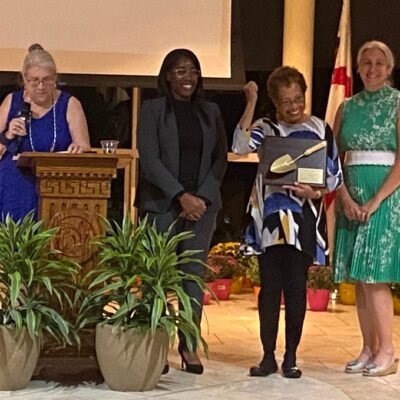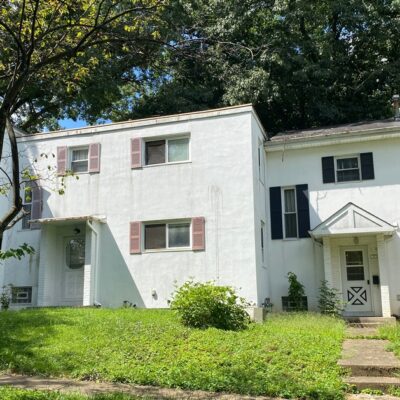Here’s a very typical yard in Old Greenbelt, especially the larger ones on the ends. Just turf and hedge,nothing else. But with more plants than I have room for in my small yard two doors down, I’ve been eying this prime location and finally asked the homeowner if I could create plant some of my extra plants there, and those of other neighbors, too. Not a gardener but a smart person nonetheless, she said sure, go ahead.
Making Borders
So I set about creating borders around the lawn as a place to put all the new plants, and that started with some orange marking paint to create the new border line, a bit of which is noticeable in the photo below. Marking paint is just spray paint that will operate while being held upside down.
Once we liked the shape of the new border, removing the sod comes next. Or not. Instead, I took the lazy gardener’s way out  and proceeded to kill the turf using the popular “lasagna method” shown below. It’s much less work than digging up sod.
and proceeded to kill the turf using the popular “lasagna method” shown below. It’s much less work than digging up sod.
The idea is to slowly smother the turfgrass and leave it there to decompose eventually. Smothering is accomplished by putting 6-10 layers of newspaper (black and white only) and/or cardboard on top of the turf, then 3 or more inches of mulch on top of that. Then wait.
But the great thing is you can still plant things through all that, especially the larger things like shrubs.
Here’s a more detailed explanation of the lasagna method of sod removal, which is sometimes called sheet composting.
Getting Free Plants
Above is a view of the entrance, with its new curving border and some extra Carexes (which look like ornamental grasses though they’re technically sedges). The other additions to the new border surrounding this service-side lawn are: large divisions of plain Hostas from various neighbors, Sedum ‘Autumn Joy‘ from a distant neighbor, 2 new Hydrangeas I decided I don’t have room for, ditto some Euphorbia amygdaloides from my last garden, and plenty of Lupines and Comfrey from old, established gardens on Lakeside Drive.
(So, how do people with empty yards find people with extra plants to help them start their new gardens without much of a budget? (Or in this case, no budget at all.) By email, mostly. So, have you joined the new Greenbelt Gardeners Yahoo Group? Almost 40 members and growing.)
The homeowner suggested I move some azaleas from the garden side that were all by themselves having no impact, and they now look great along the front door – photos of that coming soon. Or you can stop by 5G Ridge Road to see for yourself. Just please stay on the sidewalk – I promised the homeowner that visitors would.
There’s one shrub in the new border I’m really excited about – the unimpressive-looking ‘Shasta’ Doublefile Viburnum shown above. That prominent corner, with its telephone poll backdrop, could sure use a large focal point, doncha think?
So here’s what that Viburnum will look like in a few years. There are two here, forming the understory backdrop for the border at the back of my garden in Takoma Park. I loved how they looked against the forested valley below. (But, it was all too much to take care of, which a much younger couple is now responsible for doing.)
The Naturalistic Garden
The style of garden being creating in the makeover above is called naturalistic because it mimics the way plants appear in nature – grouped in masses, with the tallest at the rear and shortest ones nearest the lawn (or in nature, the opening in the forest). And importantly, lines are curves, not straight. Of course the sidewalks are straight lines, but they combine well with curved borders that soften the whole effect and again, make it look more natural.
Naturalistic gardens can be filled with sweeping grasses mixed with wildflowers, or shrubs of different heights, or all perennials, or a mix of all of these, and I prefer a mix myself. But I’ve noticed that most people want beautiful gardens with the least amount of work, and for that result the best plants are shrubs, small trees, and large grasses.
a mix of all of these, and I prefer a mix myself. But I’ve noticed that most people want beautiful gardens with the least amount of work, and for that result the best plants are shrubs, small trees, and large grasses.
Replacing lawn with larger, more deeply-rooted plants like shrubs, trees and perennials is great for retaining and cleaning stormwater, and for giving wildlife the protection and food they’re deprived of by turfgrass alone. It also makes our yards more beautiful, interesting and livable. (And I haven’t even mentioned the resources that are often used to keep lawns alive and green.)
So, for all those reasons I’ll be giving a talk about Alternatives to Lawn on Thursday, April 25, co-sponsored by the Beaverdam Creek Watershed Watch Group and the GHI Woodlands Committee. Come see the inspiring visuals!
Click here for some views of my 26-year-old, now-lawnless former garden, which I sold at the end of 2011.
















Leave a Reply